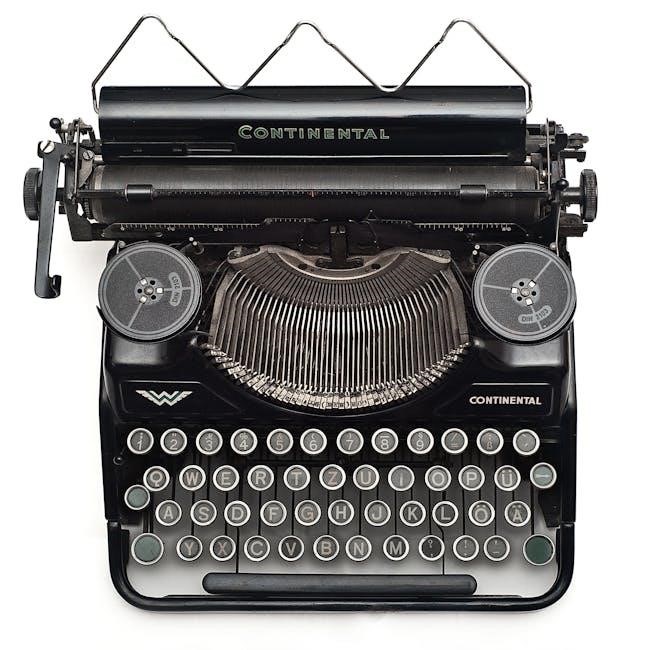Kinetix 6000 User Manual: A Comprehensive Guide
Welcome to the comprehensive guide for the Kinetix 6000 Multi-Axis Servo Drive system․ This manual provides detailed information for effectively utilizing your Kinetix 6000 system․ It encompasses setup, operation, and maintenance, drawing from resources like Publication 2094-UM001 and installation manuals, ensuring safe and optimal performance․
The Kinetix 6000 multi-axis servo drives represent a cutting-edge solution for enhancing system performance while optimizing operational costs․ Designed to accelerate and streamline processes, these drives offer a robust platform for integrated motion control within a variety of industrial applications․ This user manual serves as your comprehensive resource for understanding, installing, and maintaining your Kinetix 6000 system․
This guide will walk you through the essential aspects of the Kinetix 6000, from initial setup to troubleshooting common issues․ Referencing key documents such as Publication 2094-UM001 and the installation manual 2094-IN001, we aim to provide clear, concise instructions supported by real-world examples․ Understanding wiring, mounting, and system integration is crucial for maximizing the potential of your servo drive system․
Whether you are a seasoned engineer or new to the world of servo drives, this manual will provide valuable insights․ This includes how to leverage the Kinetix 6000’s capabilities within an RSLogix 5000 environment․ By following the guidelines outlined in this document, you’ll be able to ensure the reliable and efficient operation of your Kinetix 6000 servo drive system․
Key Features and Capabilities of Kinetix 6000
The Kinetix 6000 multi-axis servo drive stands out due to its array of features designed for optimized performance․ Central to its capabilities is the integrated motion control, which allows for precise and coordinated movements across multiple axes․ This is particularly valuable in applications requiring synchronized motion profiles, ensuring higher throughput and accuracy․
Another key feature is its compatibility with EtherNet/IP, facilitating seamless integration into existing network infrastructure․ This connectivity allows for real-time communication, diagnostics, and control, enhancing overall system responsiveness․ The Kinetix 6000 is engineered to reduce commissioning time and operational costs, ultimately improving productivity․
Further enhancing its flexibility, the Kinetix 6000 supports a range of motor types and feedback devices, allowing for customization based on specific application requirements․ Safety features, including options for IEC61508 SIL3 safety, are integral to the design, ensuring a safe working environment․ The Kinetix 6000 provides robust and versatile performance․ Refer to document 2094-UM001 for comprehensive details․
Installation Instructions: Mounting and Wiring
Proper installation of the Kinetix 6000 is crucial for optimal performance and longevity․ Begin by selecting a suitable mounting location that provides adequate ventilation and is free from excessive vibration․ Secure the drive using appropriate hardware, ensuring it is firmly attached to the mounting surface․ Refer to Kinetix 6000 installation manual 2094-IN001 for specific mounting dimensions and requirements․
Wiring connections must be made according to the wiring diagrams provided in the manual․ Ensure that all power is disconnected before commencing any wiring work․ Connect the input power wiring, carefully observing polarity and voltage requirements․ Properly ground the drive to prevent electrical hazards․ Connect the motor power and feedback cables, ensuring secure and correct connections․
Pay close attention to wire gauge and insulation ratings to meet safety standards․ After completing the wiring, double-check all connections for tightness and accuracy․ Verify that all grounding connections are properly installed․ Following these installation instructions will help ensure reliable operation of the Kinetix 6000 drive system․
System Integration Guide for Kinetix 6000
Integrating the Kinetix 6000 into your existing system requires careful planning and execution․ Start by ensuring that all components are compatible with the Kinetix 6000, including the controller, motor, and feedback devices․ Establish a communication network, such as EtherNet/IP, for seamless data exchange․ Configure the Kinetix 6000 drive using RSLogix 5000 software, defining motor parameters, motion profiles, and safety settings․
Implement proper grounding and shielding to minimize electrical noise and interference․ Utilize appropriate cabling and connectors to maintain signal integrity․ During the integration process, systematically test each function to verify correct operation․ Calibrate the feedback devices to ensure accurate positioning and velocity control․ Document all configuration settings and wiring connections for future reference․
Consider implementing safety interlocks and emergency stop circuits to protect personnel and equipment․ Adhere to all relevant industry standards and regulations․ Proper system integration is essential for maximizing the performance and reliability of the Kinetix 6000 drive system, allowing for precise and coordinated motion control․
Troubleshooting Common Issues
Encountering issues with your Kinetix 6000 system can be frustrating, but systematic troubleshooting can help resolve problems efficiently․ Begin by checking the power supply and ensuring it meets the drive’s voltage and current requirements․ Examine all wiring connections for looseness or damage, referring to the Kinetix 6000 Installation Manual (2094-IN001) for guidance․ Verify that the motor is properly connected and that there are no internal ground shorts․
If the drive displays an error code, consult the user manual for its meaning and recommended actions․ Use RSLogix 5000 to monitor the drive’s status and identify any abnormal parameters․ Check for excessive motor temperature or unusual noises, which may indicate a mechanical problem․ Ensure that the feedback device is functioning correctly and providing accurate position information․

If motion is erratic or jerky, review the motion profile settings and adjust accordingly․ If the system is experiencing communication errors, verify the network configuration and cabling․ For complex issues, consult with a qualified technician or Allen-Bradley support․ Remember to document all troubleshooting steps and findings to aid in future diagnostics․
Understanding Error Codes and Fault Diagnostics

The Kinetix 6000 drive employs a comprehensive system of error codes and fault diagnostics to facilitate troubleshooting․ When an issue arises, the drive will display a specific error code, providing a starting point for identifying the problem․ Consult the Kinetix 6000 Multi-Axis Servo Drives User Manual (Publication 2094-UM001) for a detailed list of error codes and their meanings․ These codes often indicate issues such as overvoltage, undervoltage, overcurrent, or communication faults․
In addition to error codes, the drive’s diagnostic tools can provide further insights into the nature of the fault․ Utilize RSLogix 5000 to access real-time data and monitor system parameters․ Examine the drive’s status bits and fault history to gain a better understanding of the sequence of events leading to the fault․ Check the motor’s feedback signals for anomalies or inconsistencies․
When diagnosing a fault, consider the operating conditions and recent changes to the system․ Has there been a recent software update or hardware modification? Were there any unusual events leading up to the fault? By combining the information from error codes, diagnostic tools, and system history, you can effectively pinpoint the root cause of the problem and implement the appropriate corrective action․
Safety Guidelines and Warnings
The Kinetix 6000 multi-axis servo drive is a powerful piece of equipment, and it’s critical to adhere to all safety guidelines and warnings to prevent personal injury or equipment damage․ Before installing, operating, or maintaining the Kinetix 6000, carefully review the safety information provided in the user manual (Publication 2094-UM001) and installation manual (Publication 2094-IN001); Ensure that all personnel involved are properly trained and understand the potential hazards․
Always disconnect power before performing any maintenance or troubleshooting․ Verify that all capacitors are fully discharged before touching any internal components․ Use appropriate personal protective equipment (PPE), such as safety glasses, gloves, and insulated tools․ Never operate the Kinetix 6000 in a hazardous environment, such as one containing explosive gases or flammable materials․ Ensure proper grounding to prevent electrical shock․
Be aware of the potential for unexpected motion․ Disable the drive and mechanically lock the axis before working on any part of the system․ Avoid wearing loose clothing or jewelry that could get caught in moving parts․ Heed all warning labels and never bypass or disable safety interlocks․ Failure to follow these safety guidelines could result in serious injury or death․
Kinetix 6000 and IEC61508 SIL3 Safety
The Kinetix 6000 servo drive is designed with safety in mind, and certain models offer IEC61508 SIL3 certification for safety-related applications․ This certification signifies that the drive meets stringent safety requirements and can be used in systems requiring a high level of safety integrity․ When implementing safety functions with the Kinetix 6000, it is essential to understand the specific safety features and limitations of the certified model․
Refer to the Kinetix 6000 documentation, including safety manuals and application notes, for detailed information on configuring and using the SIL3-rated safety functions․ Proper implementation requires careful consideration of the entire safety loop, including sensors, logic solvers, and actuators․ Verify that all components in the safety loop are compatible and meet the required safety integrity level․

Regularly test and validate the safety functions to ensure they are operating correctly․ Document all safety-related configurations and changes․ Be aware of any warnings or error messages related to safety functions and address them promptly․ Failure to properly implement and maintain the safety functions could compromise the safety of the system and lead to hazardous situations․ Seek expert guidance when necessary to ensure compliance with IEC61508 SIL3 standards․
Power Supply Considerations and Requirements
Proper power supply selection is crucial for reliable Kinetix 6000 servo drive operation․ The power supply must meet the voltage and current requirements specified in the Kinetix 6000 documentation․ Consider the total power demand of all drives connected to the power supply, including peak and continuous current draw during motion․ Insufficient power can lead to drive faults, performance degradation, or even system failure;
Pay close attention to inrush current when selecting a power supply․ Kinetix 6000 drives can draw a significant amount of current upon startup․ The power supply must be able to handle this inrush current without tripping or experiencing voltage sag․ Refer to the Kinetix 6000 Multi-axis Servo Drives User Manual, publication 2094-UM001, for inrush current specifications and calculation methods․
Ensure the power supply provides a stable and clean voltage source․ Voltage fluctuations or excessive noise can negatively impact drive performance․ Use appropriate filtering and surge protection to mitigate these issues․ Proper grounding is also essential for minimizing electrical noise and ensuring safety․ Consult the Kinetix 6000 Installation Manual, publication 2094-IN001, for detailed grounding instructions․ When designing the power system, consider all possible operating modes․
Motion Instructions and Programming with RSLogix 5000
Programming the Kinetix 6000 multi-axis servo drives involves utilizing motion instructions within the RSLogix 5000 environment․ These instructions allow you to define and control the motion profiles of the connected motors, enabling precise and coordinated movements․ Familiarity with RSLogix 5000 and its motion instruction set is essential for successful Kinetix 6000 implementation․ Understanding the software is also important․
RSLogix 5000 provides a library of pre-built motion instructions, such as motion axis move (MAM), motion axis servo on (MASO), and motion axis stop (MAS)․ These instructions can be combined to create complex motion sequences․ Parameters such as position, velocity, acceleration, and jerk can be configured to fine-tune the motion profiles and achieve desired performance․ Integrating motion instructions is important․
When programming, consider the application’s specific requirements․ Optimize motion profiles to minimize cycle times while maintaining smoothness and accuracy․ Utilize features like electronic gearing and camming to synchronize multiple axes and create coordinated motion․ Thoroughly test and validate your programs to ensure safe and reliable operation․ Remember, these servo drives help boost system performance․
Kinetix 6000 Drive Dimensions and Specifications
Understanding the physical dimensions and technical specifications of the Kinetix 6000 servo drives is crucial for proper system design and integration․ The dimensions dictate the required space for mounting and installation, while the specifications define the drive’s performance capabilities and limitations․ The Kinetix 6000 series offers various models, each with unique characteristics, consider the series A drives․
Key specifications include voltage and current ratings, continuous and peak torque capabilities, and supported feedback devices․ Understanding these parameters ensures compatibility with the selected motors and power supplies․ Refer to the product documentation for detailed dimensional drawings, including mounting hole patterns and connector locations․ Check the servo motor’s dimensions․
When planning your system layout, account for adequate clearance around the drives for cooling and maintenance․ Consider the weight of the drives for proper mounting support․ Precise adherence to the specified dimensions and environmental conditions is essential for reliable and long-term operation․ Incorrect specifications can lead to system failures․ Understanding the correct dimensions is critical․

Maintenance and Repair Information
Proper maintenance is essential for prolonging the lifespan and ensuring the reliable operation of your Kinetix 6000 servo drives․ Regular inspections, cleaning, and timely replacement of worn components can prevent costly downtime and system failures․ Before performing any maintenance or repair work, always disconnect power to the drive and motor․
Routine maintenance tasks include checking for loose connections, inspecting wiring for damage, and cleaning the drive’s exterior to prevent overheating․ Monitor the drive’s operating temperature and ensure adequate ventilation․ Periodically inspect the motor’s bearings and lubrication․ For repairs, it is recommended to contact qualified personnel or authorized repair centers․
Attempting to repair the drive yourself without proper training can be dangerous and may void the warranty․ When replacing components, use only genuine parts to maintain performance and reliability․ Keep detailed records of all maintenance and repair activities, including dates, tasks performed, and parts replaced․ This information can be valuable for troubleshooting future issues and planning preventative maintenance schedules․ Do not forget routine maintenance!
